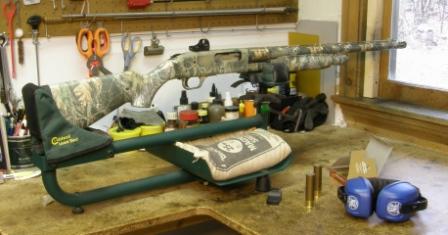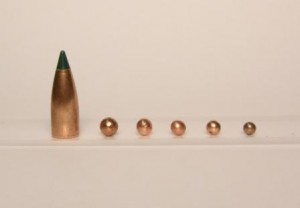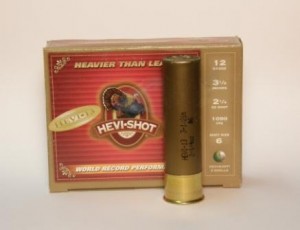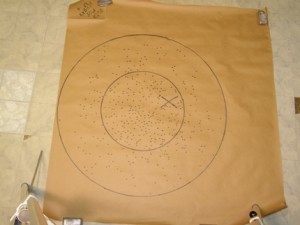Fish Fillets from Glacial Ponds
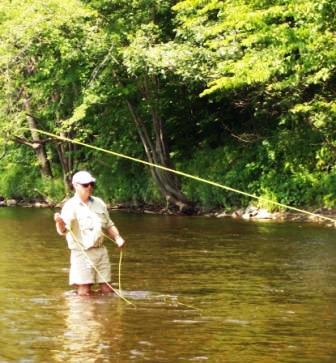
A bent fly rod means “fish on” in
Western Maine glacial ponds.
Before hiking up the three-thousand foot Western Maine mountain, my brother-in-law Bill Ormsbee stopped at the side of the trailhead to say a prayer. Bill is an avid angler, hiker, and minister
from Missouri, and always leads
with a prayer.
“Dear Lord,” began Ormsbee,
“help us to have a safe hike, to see
all your beauty, and to enjoy this
day of fishing you have blessed
us with. Amen.”
The hike only takes an hour and a half, and as we crested the summit I could see the smooth glacial pond and hear the sound of a hungry fish feeding on the other side of a huge rock that formed the south shoreline. I told Ormsbee to climb down as close as he could get to the shore, and fling his worm and bobber into the pond.
While I stood rigging my fly rod I could hear the splashing sounds of a hooked fish. Only a few minutes had passed and Ormsbee returned with a 14-inch brook trout. As I prepared to photograph him and his fish with the pond in the background, a strange noise began to break the awesome silence of the mountainous shoreline.
Before we could do anything, a small, single-prop plane crested the steep summit of the mountain and flew directly over our heads. It seemed so close that we ducked down as it passed over our position and flew straight over the pond, disappearing over the opposite edge of the mountain horizon.
We gathered ourselves to complete the fish photo, all the while exclaiming, “What is that pilot doing? Why did he come so close to us?” Then the plane suddenly crested the opposite side of the mountain and headed toward us, directly over the pond. Before either of us had time to say a thing, the pilot opened a bay door and dropped a huge load of hatchery trout into the still waters of the pond.
Most of the fish landed in the pond, but a large number of the four- to five-inch brookies landed on the rocks at the edge of the ponds – right at our feet. The flying fish didn’t hit us, but a lot of them landed around us on the shore and the shock left us standing there with our jaws hanging open. Ormsbee, the fishing minister, was the first to speak.
“I know I asked the Lord for success at fishing today,” Ormsbee exclaimed, “but I never dreamed he would send us trout from the heavens.”
We both laughed until tears rolled down our cheeks. As we scrambled to help a few of the struggling trout off the shoreline rocks and into the water, we continued to chuckle. I had heard of stocking remote ponds by using planes before, but never witnessed this procedure in such an up-close and personal manner. I couldn’t believe how close the plane came to us, and the sheer number of fish dropped baffled me and my angling brother-in-law. There must have been several hundred dropped in that one load.
Heavenly Fillets
We resumed fishing and caught several more big brook trout. Brookies, the only fish they stock in the glacial ponds, are meant to be caught and eaten. I have been assured by local biologists from Maine’s Department of Fish and Wildlife that the small glacial ponds that lace the mountains of Western Maine freeze nearly to the bottom during the winter months. Hardly any fish survive a pond that freezes that deeply, so they encourage anglers to catch and eat their limit of two fish per day.
When hiking in to fish the mountainous ponds, I always pack a sharp knife (Havalon Baracuta), a stick of butter, salt, and a pan. If I can’t build a little fire on the rocks to cook the fish, I’ll fry them over a small stove specifically made for backpacking. Nothing compares to a meal of fried brook trout at three thousand feet, especially after a day of chewing on beef jerky and power bars.
When we get up the next morning, the fishing starts well before breakfast. After we catch our two-fish limit, the fires get stoked and breakfast begins. If we remember to carefully pack in some eggs, they get tossed in with the frying fish. The combination surely makes a glorious morning meal for hungry hiking anglers.
Glacial Ponds
When the glaciers moved across the mountains of Western Maine, they carved shallow pockets at the tops of many peaks. As the huge ice chunks melted, they filled these pockets with ice-cold water.
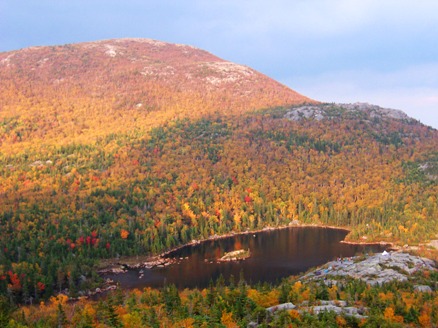
A Western Maine mountain pond
with white Kifaru tipi (kifaru.net) at shoreline (lower right).
Many of the glacial ponds in Maine’s mountains happen to be located on, or near, the Appalachian Trail (AT). The convenient thing about this is the fact that most of the well-marked AT trails near the ponds have lean-to shelters for overnight camping. This way an angler doesn’t have to pack in a heavy tent; they can simply use the provided shelters and enjoy the freedom of hiking without the added weight of a tent.
Another plus for fishing these remote, elevated ponds is that not many anglers are willing to climb a few thousand feet to go fishing. If an angler gets up early enough, they can have the whole pond to themselves. Most hikers won’t be at the summit at day break, leaving the pond to overnight anglers. Mornings on mountain ponds always provide early risers with the best fishing.
Around lunch time, hikers will start to straggle in – but not to worry, most of the hikers usually don’t fish. By dinner time, these same hikers leave to get down off the mountain before dark. Hiking anglers that prepare to stay the night have the best trout fishing time to themselves; the early morning and late-afternoon feeding frenzy. It doesn’t get much better than this.
Hiking in
Some anglers only hike in for a day of fishing, while others stay a few nights. Most of the glacial ponds in Western Maine require a two- to three-thousand foot hike, while a few reach closer to the four-thousand foot range. If I decide to hike in to those levels, I don’t want to come right back down – I’m staying at least overnight.
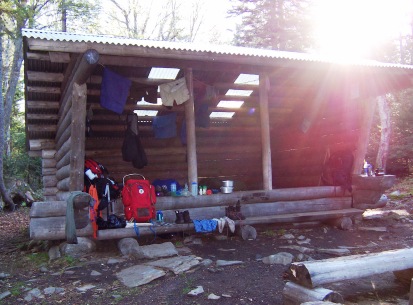
An Appalachian Trail hut in Western Maine mountains
provides great shelter for hiking anglers.
Like I stated earlier, a lot of the ponds along the AT have lean-to shelters for weary hikers, or hiking anglers. I’ve only seen other hikers using the shelters a few times in all the hiking and fishing I’ve done over the years. Still, I pack along a 9’ X 12’ silicone-treated nylon tarp just in case the
“inn is full.”
Some of the other gear I find absolutely necessary when hiking to elevated-angling locations makes a fishing trip a little easier. I don’t ever hike anywhere without SmartWool socks, some kind of wicking underwear, and a fleece jacket. SmartWool socks with a pair of liners have never allowed me to get a single blister. Wicking underwear offers warmth even if the hiker works up a chilling sweat – the material wicks the moisture away from the skin. The fleece jacket gets packed until the summit is reached, and then pulled out when the evening chill sets in. It’s surprising how warm a fleece jacket can be, especially if it’s got a quarter-zip collar that closes right up under the chin.
I also like to pack a stove and pot that boils water quickly, as well as a number of freeze-dried meals that cook up fast with the boiling water. If I don’t catch any fish, I can resort to these meals without too much fuss. I like a hot cup of coffee or tea for breakfast too, and the quick-boiling stove and pot combination take care of this in a hurry.
The last items I’ll list here, the sleeping system, ranks right up there in importance. Without a good night’s sleep, a hiking angler can’t function properly. Make sure to take a sleeping bag rated for the temperature extremes possible at that particular time of the year. During fishing season, even the coldest weather won’t be that bad – but believe me, the tops of three- to four-thousand foot mountains can get awful cold at night.
A good closed-cell sleeping pad helps soften the night’s sleep, too. This item is quite personal; I prefer a Therm-a-Rest pad that has an inflatable air chamber. The extra support of the air chamber helps alleviate morning back pains. I’ve heard other folks state that the cheap Big Box store brand, foam pad works for them – to each his own.
Fishing Methods
Some anglers prefer to fish with worms and lures on ponds that allow these methods. Although dunking a worm works perfectly, I still pack a fly rod. I can hook a worm onto a small hook on the fly rod and fling it if things get desperate.
My brother-in-law uses a bobber and worm to get his bait out a little farther from the shoreline. At times the trout can be very selective, and at other times they hit everything an angler throws at them. Some of the ponds have a five-fish-limit, and at times each of us has filled this limit using worms.
Fishing with flies presents some difficulties, but not enough to make me resort to worm fishing full-time. The cold ponds don’t offer much in the way of a hatch, but the warming thermals often pull insects up the mountains and deposit them in the ponds by the sheer force of the drafting winds.
After a late-afternoon heat wave, I have often noticed various types of bugs floating down from the sky. Flying ants, crickets, moths, and other terrestrials that don’t hatch in the water are blown in by the strong thermal mountain winds. I simulate this phenomenon by dropping similar imitations on the surface of the glacial ponds as the thermal winds begin to die down.
Believe it or not, my most successful fly takes only a few minutes to tie. I take a number 18 to 22 hook and wrap it with silver tinsel – that’s it. I don’t know what it is about that silly fly, but they hit it like mad. Maybe it reminds these “fish from heaven” of the sparkly angel wings they’ve seen as they pass from heaven to earth? What ever it is, fishing glacial ponds is truly a heavenly experience.
What kind of lure do you use when fly-fishing? Where is your favorite place to fish? Let us know, we’d love to hear from you!
7,322 total views, no views today









